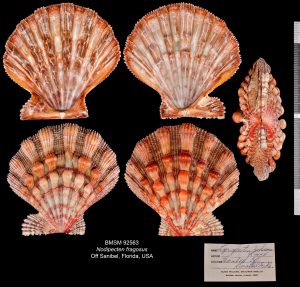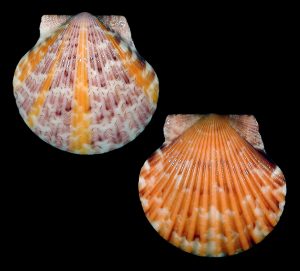Family Pectinidae
Shell size to 150 mm; the shell characterized by 9-12 large, coarse radial ribs that bear large nodules. Larger nodules sometimes hollow. A pattern of finer radial riblets is present on entire shell. Color maroon-red, but shells may be brighter red, orange, or yellow. A rare find. In the same way as the famous Junonia, Lion Paws are not uncommon in deeper water offshore, but perfect shells are almost impossible to find in local beaches. Small (juvenile) valves and fragments may be occasionally found on the beaches of Sanibel and Captiva. The species common name alludes to certain resemblance to a lion’s "hand," and the qualifier "Northern" distinguishes the North American species from its tropical western Atlantic counterpart, the Southern Lion Paw, Nodipecten nodosus (Linnaeus, 1758). The complete shell in the main image was trawled by a fishing boat off Sanibel Island. (Supplementary illustration represents valves of a juvenile specimen.)
Read MoreShell size to 33 mm; shell equivalve, valves convex, hinge with wing-like projections of unequal size. Surface sculpture of 18 to 20 ribs, each with three rows of sharp scales. Color reddish-brown, orange, rarely lemon-yellow. In February 2010, individuals of this species were found on the east end of Sanibel Island covered (both valves) with the sponge Myxilla incrustans (Esper, 1905) (see photos.)
Read MoreShell size to 90 mm; shell circular, inequivalve, lower valve strongly concave, upper valve flatter, slightly convex. Hinge with wing-like projections of equal size. Sculpture on upper (flat) valve of about 35 relatively wide ribs and narrower interspaces. Do not confuse with Euvola raveneli, which has the lower valve with "doubled" ribs and narrower interspaces. Lower (deep) valve with about 20 less prominent ribs. Color tan to light-brown. Inner surface of lower valve white. Upper valve mottled with reddish-brown and dark-brown markings. The live animal has whitish mantle margins and silvery, or very pale-blue eyes. Image of living scallop from Kice Island by Amy Tripp, January 2016.
Read MoreShell size to 60 mm; shell circular, inequivalve, lower valve strongly concave, upper valve flatter, slightly convex. Hinge with wing-like projections of equal size. Sculpture on upper (flat) valve of broad and widely spaced ribs. Do not confuse with Euvola ziczac, which has the lower (deep) valve with single, not "doubled," ribs and narrower interspaces on upper valve. Upper valve darker shades of brown, lower valve whitish, sometimes yellowish, orange, or pink. Inner surface of lower valve white. Upper valve mottled with reddish-brown and dark-brown markings. Main figure shows external surfaces of lower and upper valves, next image shows internal surfaces of same valves, third illustration shows a lower valve (two views) with pinkish external surface found by Kimberly Nealon on Bowmans Beach, Sanibel, on July 4th, 2016.
Read MoreShell size to 75 mm; shell valves convex, hinge with projections of about same size. Upper valve less convex than lower valve. Surface sculpture of 19 to 21 strong, squarish ribs. Lower valve light color, usually white. Upper valve brownish, reddish, or grayish. A recent study has shown that the subspecific nomenclature for southwest Florida populations of the bay scallop is still unresolved.
Read MoreShell size to 64 mm; shell outline almost circular, valves inflated, hinge straight, wing-like projections relatively poorly developed. Surface sculpture of about smooth 20 ribs. Upper valve light-color, with pink, orange, or brown markings. Lower valve color is much lighter, and has lighter markings.
Read More




